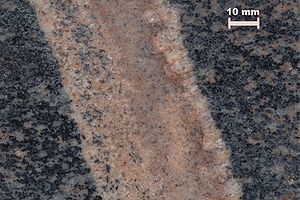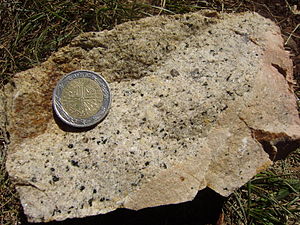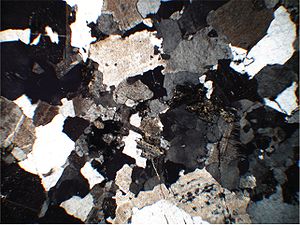Aplit

Aplit is a group name for light mineral-rich, fine-grained and dense leucocrate dykes associated with plutonites or metasomatically modified rocks. Aplite are characterized by a very low content of mafic (below 5 percent).
Etymology and terms
The name Aplit is derived from the Greek ἀπλος (haplos), which simply means. It was first introduced into scientific literature by AJ Retz around 1800 and later (1823) by Karl Cäsar von Leonhard , probably based on the relatively simple mineralogical structure of the rock.
The prefix Aplo- is used to denote light, mineralogically simply composed rocks, which are depleted in ferromagnesian minerals. Examples are the aplodiorite and the aplogranite . The term aplosyenite , introduced by Walter Ehrenreich Tröger in 1935 in his special petrography of igneous rocks , is no longer used.
distribution
Due to their association with granitoids and occasionally more basic igneous rocks such as B. Gabbros , aplites occur worldwide ( basement , orogen , batholith , intrusions and igneous provinces).
education
Aplites are very light, dense, fine-grained to aphanitic vein or vein rocks. Their color can vary from white to light gray to pink or flesh-colored. The aisles can be zoned. Their structure is usually very uniform and non-porphyry. The grain size is in the sub-millimeter range and a magnifying glass is therefore required to identify the minerals . Due to the small and very uniform grain sizes of magmatic aplites, a very rapid and simultaneous crystallization can be assumed. The crystal forms are predominantly hypidiomorphic, the structure is like a mosaic. The speed of the Aplite is usually in the centimeter range, less often in the decimeter range, occasionally in the meter range. Very rarely they can also form smaller sticks or irregular clusters inside or on the edge of plutons . Aplitic marginal zones are often found on pegmatites .
Chemical composition
Aplites are mainly composed of quartz , alkali feldspar (mostly orthoclase or microperthite ) and plagioclase . They are very poor in mafic minerals (usually biotite ), with their color number usually below 5 (hololeucocrate), but in combination with more basic intrusives this can rise to 10. Their chemistry is often very similar to the composition of the fine-grained gusset filling of porphyry parent rocks. Strikingly, this is the eutectic composition of granitoids. Your alkali feldspar can occasionally adopt porphyry tendencies, but quartz almost never. This underlines their association with granophyres , quartz porphyries and rockites . Aplites associated with diorites and quartz diorites usually show a slightly different composition, so they mainly contain plagioclase ( oligoclase ) as well as muscovite , apatite and zircon . Syenitaplite show mainly alkali feldspar, including in the rare Eläolith also -Syeniten nepheline can join (nepheline leading aplites were formerly known as Aploide called). If the quartz content increases significantly, aplites can also transform into quartz veins by means of very quartz-rich modifications such as beresite .
Biotite and other ferromagnesic (Fe-Mg-containing) minerals occur only rarely or hardly at all.
In addition to pneumatolytic minerals such as topaz and fluorite , tourmalines can also occur.
Aplites often show increased concentrations of the elements beryllium and lithium .
Emergence
Aplites can arise through two very different processes:
- magmatic
- metasomatic
Magmatic formation
If the puzzle criterion is met , i. H. the seamless joining of the host rock or the seamless closure of the duct crevices, it can be assumed that aplites represent the molten filling of tearing expansion crevices or crevice systems in plutonic rock bodies. They are injected as residual eutectic melt in the magmatic state in the late stage of the respective plutons. The small grain size of the aplite suggests that the residual melt has cooled down quickly.
Metasomatic origin
If the assessment of the puzzle criterion turns out negative, a metasomatic formation of the aplites must be assumed, ie their formation took place in situ by means of chemical reactions (metasomatic differentiation) in the solid state, displacements of the host rock did not occur. Chemical mass transfer is usually only effective in the centimeter to decimeter range. The host rock ( paleosome ) is mostly depleted of light components such as feldspars (this turns it into a melanosome ), which then accumulate in the leukosome , the aplite. In comparison with their parent rock, metasomatic aplites are mostly enriched in SiO 2 .
Varieties
Aplogranite or granite aplite are light-colored rocks with the same composition as granite , but in which biotite is rarely or not present. In addition to the granite aplites, there are also syenite , diorite and gabbroaplites .
Microaplites are extremely fine-grained fillings of cavities and cracks in syntectonic granitoids . As the deformation progresses, the granitoids can no longer completely crystallize out because of the tensile stresses that become effective. In addition, grains that have already crystallized out are split or torn. The remaining residual melt is therefore forced to a rapid crystallization process in the cavities that are created. The resulting fillings consist of tiny plagioclase ( albite , oligoclase) and xenomorphic quartz grains with often bulged and toothed edges. Significantly, microaplitic fillings do not lead to low-temperature, cracked microclines .
Type of natural stone
Due to their occurrence as relatively thin vein rocks, aplites are rarely traded because they are only found in limited quantities.
Example:
- Grigio Argento: Aplit from Sardinia
Individual evidence
- ↑ MJ Hibbard: Deformation of incompletely crystallized systems: granitic gneisses and their tectonic implications . In: J. Geol. Volume 95 , 1986, pp. 543-561 .
literature
- Hans Murawski: Geological Dictionary . Ferdinand Enke Verlag, Stuttgart 1992, ISBN 3-432-84109-4 .
- Dietmar Reinsch: Geology . In: Training center for the stonemasonry and sculptor's trade (ed.): Steinmetzpraxis: The manual for daily work with natural stone . 2. revised Edition. Ebner Verlag, Ulm 1994, p. 225 .
- Wolfhard Wimmenauer: Petrography of igneous and metamorphic rocks . Ferdinand Enke Verlag, Stuttgart 1985, ISBN 3-432-94671-6 .


